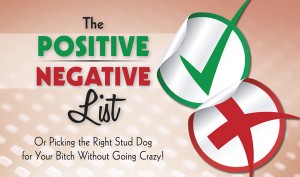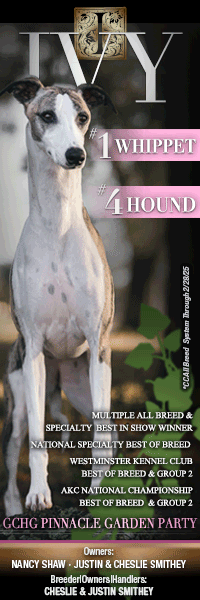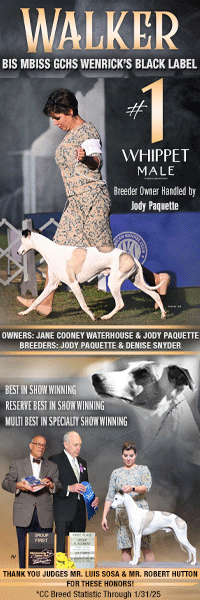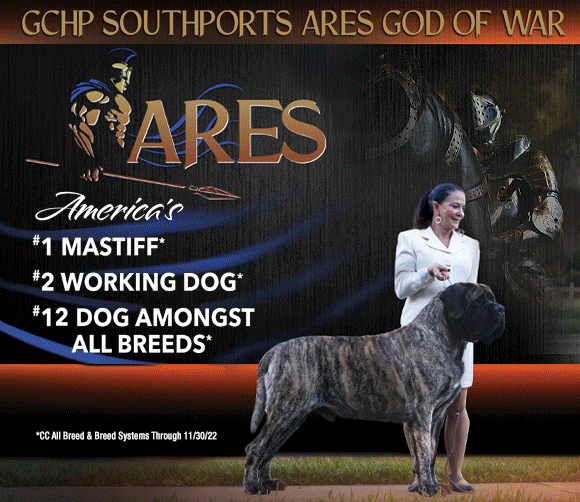From The CC Vault: The Positive-Negative List
by Peri Norman
 Our world is filled with advice on breeding dogs and much of it is very good. Examples include, “pick a stud dog who will improve your bitch’s weak points.” Or, “find a stud dog whose faults will not overpower your bitch’s attributes.” “Never double up on a fault,” is another common bit of wisdom. Some people will encourage us to pick proven stud dogs that have not produced serious problems we don’t want like cancer or hip dysplasia. Mentors advise that finding a dog with an excellent temperament is critical. Breeders who are fairly new or wanting to expand their knowledge listen carefully to the tidbits offered by those more experienced. Yet somehow the task of picking the right stud dog never gets any easier.
Our world is filled with advice on breeding dogs and much of it is very good. Examples include, “pick a stud dog who will improve your bitch’s weak points.” Or, “find a stud dog whose faults will not overpower your bitch’s attributes.” “Never double up on a fault,” is another common bit of wisdom. Some people will encourage us to pick proven stud dogs that have not produced serious problems we don’t want like cancer or hip dysplasia. Mentors advise that finding a dog with an excellent temperament is critical. Breeders who are fairly new or wanting to expand their knowledge listen carefully to the tidbits offered by those more experienced. Yet somehow the task of picking the right stud dog never gets any easier.
One thing that I have noticed is that some would-be or beginning breeders take every piece of advice to heart. This not a bad thing unless one ends up paralyzed and unable to make a good decision in an attempt to avoid faults in the stud dog of choice. No stud dog is perfect. You can search high and low, but you will not find him. There is a way out of this conundrum. It involves thoughtfully creating a list of “acceptable” negative traits. It sounds crazy, but much like in judging we must teach ourselves to balance a dog’s faults against its attributes. Annie Clark once said that judging a stud dog or brood bitch class is like playing a hand of cards… the best hand wins. So it is when we are seeking to create a breeding pair that will produce the most (and most important) attributes with a minimal number of detrimental characteristics.
The importance of starting with a thorough knowledge of your bitch’s strengths and weaknesses cannot be overemphasized. This includes a careful of evaluation of the details of her structure and type. Using the sections of the standard and comparing each part of her against the ideal described therein should give you a fairly good picture. You will probably need to expand the section on temperament. Most standards give a good overview of what a breed is generally like, but most of us have preferences/requirements depending on the activities we participate in that might include instinctive talent at whatever task the breed was originally to perform, or it may include specific attributes like excellent dog-dog skills or things like biddability, work ethic, energy level and resilience. Finally, it is extremely important to prioritize health concerns; everything from the deadly and debilitating, to missing teeth and testicles, to chronic ear infections. The list of health issues will vary from breed to breed, but it needs to be as complete as possible.
One important part of this process is asking for input from other people who you feel are knowledgeable and honest. Love is blind. Regardless of our best attempts to separate our emotional attachment to a dog from an objective consideration of her value as a show or breeding animal, you will always have blind spots. Close friends and honest mentors can help us to see those blind spots in a way that illuminates our vision without negating the positive attributes we treasure.
Once you have made an accurate and objective evaluation of your bitch, then you need to find as much information as you can about her parents, grandparents and siblings or half-siblings in all three generations. The picture of these dogs that you create will not be as complete as the one you made for your own bitch, but the more information you can include about reasonably close relatives, the better chance you have of making a good breeding decision.
Now, instead of thinking of your bitch as an individual with strengths and weaknesses, visualize her as a sort of genetic bank account. The information that you have collected about all of her close relatives, taken in aggregate, will give you a deeper understanding of what she is likely to produce based on the strength of her genetic background. It will also shed some light on what she might produce depending on the strengths of the contribution of the stud dog. Finally, you may get some ideas what she may not produce even bred to a stud dog strong in that area. This latter evaluation often involves the types of traits that take multiple generations to fix in a breeding program.
Make a list of potential stud dogs. Evaluate them both as an individual and as a hypothetical genetic bank account. In order to make a sound decision, we must know what each partner is bringing to the table in the potential match. On the one hand, this can be even more difficult than it was with your bitch because information may not be as readily available. On the other hand, proven stud dogs will have offspring available for you to evaluate as well, always keeping in mind that someone else’s bitch was half of that equation. This is particularly helpful in figuring out that “middle category”; the one where a breeding animal CAN produce a positive (or negative) trait when it is bred to a partner whose pedigree contains a number of dogs exhibiting that trait. I once heard a dog called a “tread water dog” because regardless of the style or quality of the bitch he was bred to, the litter was a “reflection” of her. What a marvelous find for someone with an excellent bitch!
It is important to include an assessment of the reliability of the information you are receiving about both the dog and your bitch. There are people who keep extensive lists and/or databases about health information related to dogs in their breed. Sometimes, they can tell you where or how they learned about a particular tidbit of information. Other times, it seems as though it just magically appeared in a database with absolutely no supporting information and no way to determine validity. As in so many other areas of our lives, it only makes sense to be a little bit skeptical and confirm as much information as you can. As a person who has been on the receiving end of some pretty remarkable smear campaigns against my dogs, I can tell you that Winston Churchill hit the nail on the head with this line, “A lie gets halfway around the world before the truth has a chance to put its pants on. “ It would be a shame to pass on an excellent stud dog because of untruthful “information”. The best source of information about any dog is the owner and/or breeder. While there are a few who own and breed “perfect” dogs, most people will be honest and candid.
The next step is to evaluate the potential breeding pairs by integrating the information you have compiled on the bitch and her various potential suitors. Here is where it gets tricky! This is the stage where most people begin to cross dogs off the list. It could be that Susie has a littermate with light eyes, and Fred has an uncle with light eyes as well. When any doubling on an unwanted characteristic automatically results in a cross-off, the inevitable result is no dogs left on the list. Some people even go so far as to make a new list (often with dogs of lesser quality than those on the original list) and start all over again. This endless loop of researching and rejecting leads to frustration, exhaustion and bitches that never get bred. The old adage, “If you are not part of the solution, you are part of the problem,” comes to mind. If, in fact, you have a quality bitch with a contribution to make to your breed’s gene pool, not breeding her because of fear of producing a fault or some less than desirable health or temperament trait, then you are doing your bitch and your breed a disservice. Perfection is not required. Honesty and your best effort are necessary.
Enter the positive/negative list! You can keep your original choices of suitors, but before you eliminate any of them from consideration, look at your bitch and her genetic bank account from the opposite direction. Turn it upside down and ask yourself which qualities are she and the majority of her relatives most strong… strong enough that they could “carry” most of the pups even bred to a dog whose fortune was not that particular attribute. You can also think about which traits are a mixed bag for your bitch and her relatives. These are crucial traits which your bitch may produce if bred to a dog with a strong genetic background in these areas, or not, if bred to a dog weak in these areas or coming from a family frequently displaying these shortcomings. Write it down, or at least firmly fix in your mind, the “negative” traits that your chosen stud dog is “allowed” to have. This is a concrete way of recognizing that no dog is perfect and that as responsible dog breeders, we get to choose not only which traits to emphasize, but also those traits that may be desirable, but not mandatory.
Another way to formulate the “positive/negative list” is look at it like a bell curve. On the very top are just two or three traits which are “must-haves”. In the middle are many traits of weighted value based your evaluation of your bitch’s bank account. At the far end of the bell curve are the traits that are of minimal importance. These are the ones that you can live with as a part of your breeding program, at least for another generation or two. This is really the breeders version of not fault judging. Virtues and weaknesses have to be thoughtfully weighed in order to determine the best possible package. Understand, that the more information you acquire and attempt to include in your objective evaluation, the more compromises you will be required to make. However, the Herculean effort required to attain and balance all that information will be worth it when you look into the whelping box and find what you hoped and planned for all along.
Short URL: https://caninechronicle.com/?p=256424
Comments are closed












